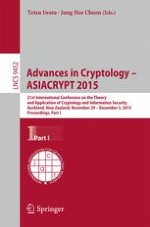2015 | OriginalPaper | Buchkapitel
QA-NIZK Arguments in Asymmetric Groups: New Tools and New Constructions
verfasst von : Alonso González, Alejandro Hevia, Carla Ràfols
Erschienen in: Advances in Cryptology -- ASIACRYPT 2015
Verlag: Springer Berlin Heidelberg
Aktivieren Sie unsere intelligente Suche, um passende Fachinhalte oder Patente zu finden.
Wählen Sie Textabschnitte aus um mit Künstlicher Intelligenz passenden Patente zu finden. powered by
Markieren Sie Textabschnitte, um KI-gestützt weitere passende Inhalte zu finden. powered by
